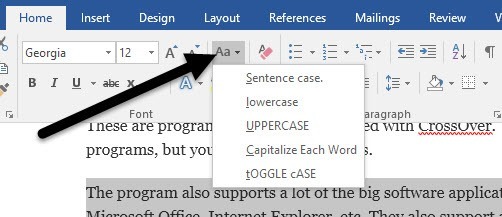

Zapier includes options to Capitalize, Lowercase, Titlecase, or Uppercase your text. Select Formatter as the app in the 2nd step, choose the Text action, then select the correct capitalization you want in the Transform menu. You might want something to double-check and make sure your title is correctly capitalized before it gets published.īuild your Zap as normal, selecting the trigger app you want to start your automation. Or say you want to write your blog posts in Evernote, and then have Zapier publish them on WordPress automatically. But your titles will be capitalized-and that might not be your Tweet style. Zapier can do that for you, watching your RSS feed for new posts and then sharing them on Twitter for you. Say you want to automatically Tweet your new blog posts. But when your copy is in other business tools, such as your newsletter manager or an email draft, you need something to make sure your text capitalization is correct before sharing with the world. Small Caps changes the entire selected text to smaller variations of capital letters other than the first character of a word,Īll Caps is similar to the UPPERCASE option within the Change Case drop-down gallery.Zapier can automatically capitalize your textĪpps with built-in capitalization tools work great when you've just written something and realize you need to switch the case-these are most often text editors. Choose as required and click the OK button within theįigure 6: Text Case check-boxes within the Font dialog boxįigure 7, below shows samples of the text applied with Small Caps and All Caps options.

Within theįont tab of Font dialog box you'll find two text case check-boxes: Small Caps and All Caps This opens the Font dialog box, as shown in Figure 6. To access this dialog box, click the dialog launcher within the Font group, highlighted in blue withinįigure 2, shown earlier on this page. These options can be found in the Font dialog box. In addition to the five case options explained in this tutorial, PowerPoint 2013 offers two more options: Small Caps andĪll Caps.

To change the text case, make sure the text is selected.This is useful if theĬaps Lock key was inadvertently left on while typing! Reverses the case of each letter of the selected text to the opposite of the current case.Also known as Title Case, this will capitalize the first letter of each word.Does not do anything to numbers or symbols. Converts all characters to uppercase that are not already so.It does not do anything to numbers or symbols. Converts all characters to lowercase that are not already so.Capitalizes the first letter of the first word in the sentence, or bullet point.Within the Change Case drop-down gallery there are five options:.This brings up the Change Case drop-down gallery, as shown in Figure 3.In Figure 1, we have selected some text that seems to be suffering fromĪnd click the Change Case button, highlighted in red within Figure 2. Open any presentation and select the text you.Rather than retyping the whole text again, you can use PowerPointĢ013's Change Case option to quickly change the case of selected text on your slide: Whoever sent you the content is one of those people who type everything in small case, or maybe they just turn on the Caps Lockīutton and forget turning it off! Whatever the reason may be, you will end up with text that is certainly not usable on your The problem with this approach may stem from the fact that And rather than typing all that content, you may justĬopy it from an email or a document, and paste it within PowerPoint. Often, you may receive some content for your presentation from someone.


 0 kommentar(er)
0 kommentar(er)
